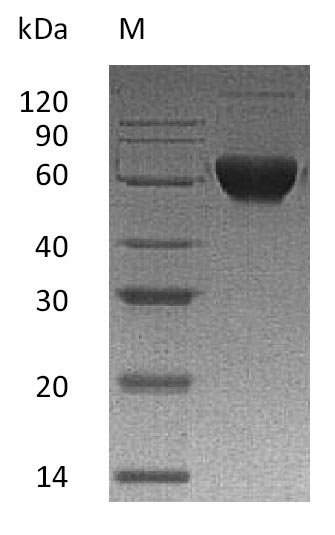This Recombinant Human ACVR2B protein is a crucial research tool for investigators in the field of signal transduction. The protein, which corresponds to the 19-134aa expression region of the Activin receptor type-2B, is expressed in mammalian cells and carries a C-terminal 6xHis-Fc tag. Supplied as a lyophilized powder, the protein can be easily reconstituted with sterile water or buffer for various experimental applications.
Our Recombinant Human ACVR2B protein is held to high quality standards, with a purity of greater than 95% as determined by SDS-PAGE analysis. Endotoxin levels are maintained below 1.0 EU/µg as assessed by the LAL method. The protein exhibits full activity, as evidenced by its ability to bind Human Activin A in functional ELISA with an ED50 of less than 100 ng/ml.
ACVR2B (Activin receptor type-2B) has emerged as a crucial protein in various biological processes, as evidenced by several studies investigating its functions and therapeutic implications. ACVR2B, a transmembrane serine/threonine kinase receptor, plays an essential role in modulating the transforming growth factor-β (TGF-β) signaling pathway, which regulates cell proliferation, differentiation, and apoptosis. A study by Tsuchida et al. (2008)[1] provided a comprehensive review of the biological roles and functions of ACVR2B, emphasizing its involvement in myostatin signaling, which influences muscle mass regulation. ACVR2B's therapeutic potential was further highlighted by Latres et al. (2015)[2], who demonstrated that the inhibition of ACVR2B signaling using a ligand trap, RAP-031, significantly improved muscle growth and function in a mouse model of Duchenne muscular dystrophy (DMD), making it a potential candidate for the treatment of muscle-wasting disorders. More recently, research by Costamagna et al. (2020)[3] investigated the role of ACVR2B in modulating bone homeostasis and its implications in osteoporosis treatment, revealing that ACVR2B inhibition led to increased bone mass and improved bone strength in a mouse model.
References:
1. Tsuchida K, et al. Activins, myostatin and related TGF-beta family members as novel therapeutic targets for endocrine, metabolic and immune disorders. Curr Drug Targets. 2008;9(6): 476-80.
2. Latres E, et al. Activin A more prominently regulates muscle mass in primates than does GDF8. Nat Commun. 2015;6: 10147.
3. Costamagna D, et al. ACVR2B/Fc counteracts chemotherapy-induced loss of muscle and bone mass. Sci Rep. 2020;10(1): 12094.




